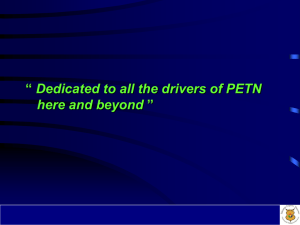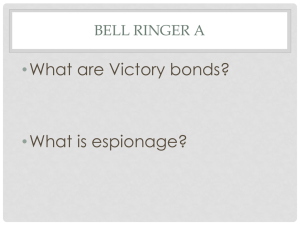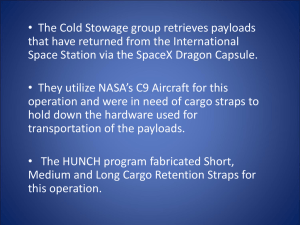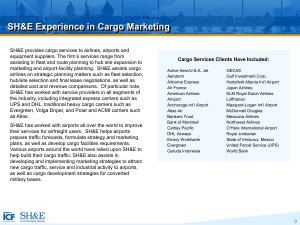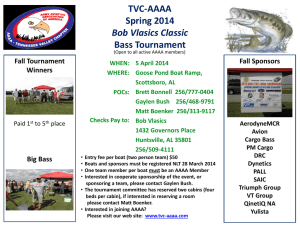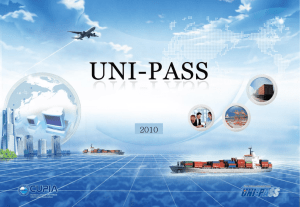Effective Tanker Training
advertisement
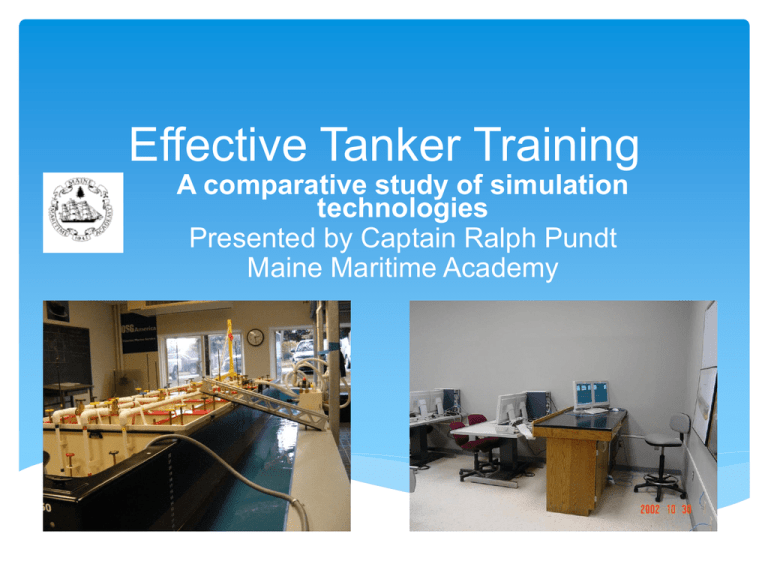
Effective Tanker Training A comparative study of simulation technologies Presented by Captain Ralph Pundt Maine Maritime Academy There are many impressive training tools on the market today, without which we would not be able to meet the requirements of STCW. Institutions must invest in these high tech training tools to remain compliant and relevant as a world class Maritime Training Institution. The trick is to blend the educational value of a simulator with the abilities of the students. Students have a knack for technology and can quickly learn to “manipulate” complex systems. Without gaining a true understanding of the reasoning or direct cause and affect of the process. is happening? Learn to crawl before you walk Dangerous cargo simulators are no different. They are very useful in developing a strong reinforcement and an advanced understanding of the complete cargo operation. They can however overwhelm novice students Numbers and flashing lights have no meaning unless the students can relate to their meaning. Educational Objectives STCW and USCG mandate the basic requirement for a dangerous liquid cargo course. But novice Students must gain a stronger fundamental understanding of basic cargo flow, the effect of improper weight distribution on a floating vessel, and proper cargo system lineup. Must develop stronger leadership and communication skills, and understand the value of a positive team effort . Basics of a DL course In addition to the USCG/IMO course requirements the class outcomes should include: Learn to develop and execute a well defined cargo plan. Learn to develop and visualize proper cargo flow techniques Learn to work within a command structure Learn to effectively communicate Learn to work as a cargo team Understand the cargo system Learn to work within the limitations of the vessels cargo system Learn to manage and visualize the weight distribution of the cargo Learn to task manage, safety considerations such as line handling and gangway safety during cargo operations. Understand and visualize the effects of their actions Understand the role of the shore representative Learn to work within the constraints of the international safety and pollution regulations Make it as real as possible ! OSG 305 Step One, Learn the system Develops a clear understanding of cargo system Pump room Line up 3 centrifugal Main Cargo Pumps 2 Positive displacement stripping pumps 2 Cargo eductors 1 Segregated ballast system Ballast eductor strippers Designed to discharge all cargo in 50 minutes 18’~ 5.48 m loa 2’~ .6m molded depth 4’~1.2m beam Shore Cargo Tanks 3 separate cargoes from 4 ~ 250 gallon shore tanks Displacement overflow tanks Pump room line up Electronic Simulators ` Pros Multiple operations Cargo flow Inert Gas Ballast Crude oil washing Stress and stability calculations Theoretical list and trim management Pros ~ Electronic Simulator Provides a total overview of all systems Provides the opportunity for the students to control a multi function operation Stability and stress control Cargo planning to include multi weighted cargo Provide a strong understanding of the over operationall management of cargo operation Floating Model ~ Pros Visualization of all aspects of the cargo transfer Multi product top off sequencing Multi product stripping sequencing Real cargo flow which reacts to actual flow adjustments and which provides a clear visualization of events as they unfold Sound : the students can hear and appreciate the sounds associated with the pump room. Team work skills Communications skill Cargo planning skills Group Dynamics Pros~ Floating Model Multi Cargo Transfers Load and discharge sequence planning Pumping techniques Provides clear visualization of cargo transfers Provides a clear understanding of weight distribution in a floating vessel Provides an opportunity to develop and work within a positive command structure Provides a opportunity to develop proper verbal and written commandscommunication techniques Pro ~ Floating Model Because they can hear the pumps, the students develop a sense of understanding when air has entered the system. They learn to appreciate the value of eductors and positive displacement pumps while stripping the tanks They clearly understand the value of trimming the vessel by the stern to pump out the maximum quantity of cargos The key advantage is that they can visualize what is happening and develop a keen sense of situational awareness Electronic Simulators ~ cons Simulators are not designed to be operated with in a group dynamic. Cargo and pressure flow is not clearly understood by the novice student, as the depiction of such flow is illustrated numerically. The subtle changes in the system are not apparent to the novice student and is not easily understood until the student has gained more experience There is no sound associated with the simulation. Students need to understand the language of the pumps and feel the pressures in the system. This can not be done “yet” in simulation. System Complexity; for a novice student these systems can become overwhelming. Once overwhelmed, the scenario reverts to a video game. The students must develop an understanding of the fundamentals of the operation before they can learn to multi task in a more complex system. Model Simulation ~ Cons Can only simulate cargo and ballast control Unable to simulate stress calculations Requires a substantial infrastructure Cons~ Floating model Can not determine stresses or initial stability conditions “yet” Although three cargoes are being loaded they are of equal weights. There are only two systems to manage Ballast and main cargo systems But that is enough and will not over whelm the students Training Sequence MMA offers a basic and an advance tanker course. The basic course primarily uses the floating model while the advance course uses the electronic simulator. 2nd Semester Sophomore – NS 210 establishes the ground work for a positive cadet shipping experience Cadet shipping/Coop- Experiential on the job learning Last semester- Ns 412 Advanced tanker operations enhances their accumulated knowledge focusing on tanker management and combined systems operational management Electronic DL Simulator It is difficult for the novice student to understand what the numeric associated with pressure, temperature and cargo flow represent. Although realistic to the operation of modern tankers this system is better served by a student who has a greater understanding of tanker operations than a 2nd year student It is a great teaching aid for advanced tanker operations, and for students who have completed the basic course and have had the opportunity to cadet ship aboard a tanker. Group Dynamics A Lab consists of Person in Charge Mate on deck 2 seamen 1 Pump man 1 shore representative 1 observer/ log keeper Responsibilities Title Job Description Responsibility Chief Mate Over all in charge, develops and executes the load/discharge plan Over all in charge, responsible to the Captain and charterer (instructor) Mate on deck On Deck coordinator Directly responsible to the Chief mate 2 Able Bodied Seamen Assist as Directed – Sound tanks- make valve adjustments, handle lines and tend the gangway Responsible to the mate on deck Shore Representative / Observer Record keeper Keeps all logs- takes debrief notes- lines up shorecontrols cargo flow responsible to the chief mate Pumpman Lines up and operates all shipboard pumps, conducts ballast operations responsible to the Mate on Deck Observer’s Debrief Notes What worked: Good Communication between Chief mate and Deck mate (In what way?) AB's carried out direction as best they could (leads to a discussion for clarity) Chain of command was understood Team worked well with each other (In what way?) Shore communications and use of shores ability to slow flow What didn’t work: AB's were left out of the bigger picture, which might have given them a chance to think ahead (leads to a discussion for clarity) Start and stop times should have been more staggered Had one safety tank for two types of cargo (weren't used) Missed valve on initial line up (How can that be avoided?) AB's were too busy to make judgment when needed (leads to a discussion for clarity) Improvements: Need to tend lines Overall system understanding Communicating overall picture to AB's Port LOG Arrival/NOR Pilot Ab All Fast Com. Inspection Dry Cert OSG 350 Tugs A/s Cargo 1 Date Tugs A/w Cargo 2 Cargo 3 Type/Cargo Hoses ON Commence Cargo Stop Resume Stop Resume Finish Cargo Hoses off Cargo Time Total Time Complete Insp Paperwork Ab Pilot Ab Vessel Released PIC Ship Ship’s Log Signature and Date Tugs A/s Pic Shore Tugs A/w Conclusions Students rarely communicate effectively Verbally, Written, Visually, using radios So where ever and when ever there is an opportunity to develop these skills use them We must always challenge our students so that they have the tools and desire to advance their knowledge. “They don’t know, what they know, until they are challenged” Thank you ralph.pundt@mma.edu Maine Maritime Academy Castine, Me Main Dk Drawing Key Below deck Pumproom



